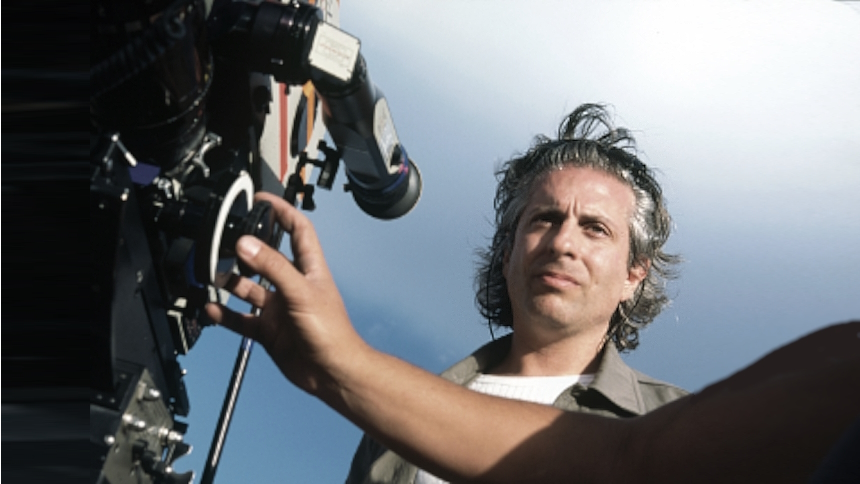Sound And Vision: E. Elias Merhige

In the article series Sound and Vision we take a look at music videos from notable directors. This week: a trio of music videos directed by E. Elias Merhige.
Several famous directors have tackled remakes of Nosferatu, most noticeably Werner Herzog, and now Robbert Eggers. But one re-adaptation of Nosferatu, called Shadow of the Vampire, flew kind of under the radar. Its director is E. Elias Merhige, who has had an erratic but interesting career, starting out with the avant-garde arthouse-horror Begotten; following it up with the aforementioned film about Nosferatu-portrayer Max Schreck being a real-life vampire; making the interesting serial killer thriller Suspect Zero, and then continuing the work in the Begotten-trilogy by finishing it with the shorts Din of Celestial Birds and Polia and Blastema.
Before he finished the trilogy that he started with Begotten, Merhige dabbled in music videos, making three of them in 1996, well before he made his second feature. While the artist is rightfully controversial currently, Marilyn Manson was partly responsible for helping give Merhige's career a second wind. Apparently, Manson was a superfan of Merhige's Begotten and played it on a loop when recording his seminal album Antichrist Superstar. He even instructed album sleeve designer P.R. Brown to watch Begotten and use it as a source of inspiration for the artwork.
Then Manson approached Merhige, who made two music videos off of the album. Cryptorchid (below) leans heavily on footage from Begotten, re-edited to fit the narrative of the music video, and interjecting a few shots of Manson. The same approach is present in Antichrist Superstar (also below), which mixes newly shot footage with footage from Begotten ánd a lot of war imagery from fascist regimes. Manson was hesitant if his anti-war message came across. He wasn't the only one who wasn't fully convinced, as Interscope felt the quality of the footage was unreleasable.
The thing is, Begotten is as a film at times impenetrable visually. The deliberately murky and off-putting footage in it was there to evoke, in the words of Merhige himself something that was from a very distant past: "I wanted Begotten to look, not as if it were from the twenties, not even as if it were from the nineteenth century, but as if it were from the time of Christ, as if it were a cinematic Dead Sea Scroll that had been buried in the sands, a remnant of a culture with customs and rites that no longer apply to this culture, yet are somewhere underneath it, under the surface of what we call "reality."".
Begotten is a truly disturbing piece, lodged from time and place in a way that is truly unsettling, even beyond its grotesque and shocking imagery. It is kinda weird that Manson's involvement dulled the edges of the film, which is counter to what you would expect. Interscope didn't want to release the music video, and just as Begotten itself became a big cult hit through bootleg culture, the reputation of Antichrist Superstar started to grow, the more it lingered in obscurity. It was finally released online after 15 years of bootlegging.
Merhige has been working in the shadow of Begotten, in some ways eversince, even though he successfully expanded the scope, tone and visuals of the trilogy in its sequels. But I would be loath to mention another music video he made. After also having made a music video for Danzig, called Serpentia in the same year as Cryptorchid and Antichrist Superstar, it almost took ten years for Merhige to make another video. But it's an all time great one. Interpol's The Heinrich Maneuver boggles the mind in a very different way than Begotten or Shadow of the Vampire does. It is a slow motion video that uses the extreme delay in the footage to ramp up the tension. In addition to the unnatural delay of time, he also zooms in to an extreme extent making the grainy texture of the footage almost feel haptic. The most interesting thing happening is the overlay of several planes of imagery, that all tell a different story, that is interconnected.
On one plane a waiter runs to the scene of an accident. On the second plane we see a businessman and an elderly lady witnessing said accident. And in the front we have a model looking in a hand mirror, obviously missing an oncoming bus crash to which she will fall victim. The three planes look interconnected at first, but the closer we get to the crash, the more Merhige starts to play with time and storytelling.
Eventually the first two planes reverse time, playing backwards, while the third plane continues to push the victim to her untimely demise. The reversal of the footage for some of the planes, while not for the main subject (the model), noodles the brain in an extremely interesting way. But the emotional impact is even stronger: by reversing the actions of the witnesses and the people who want to help the victim, the inevitability of it all really comes across as a punch in the stomach. It is an extremely intelligently done video, pushing forward what a Merhige-artpiece could be. While the Manson-videos are fine as is, and have been impactful in their own way, it is The Heinrich Maneuver that really broke the mold and stood the test of time.







